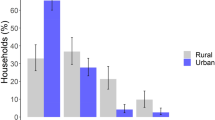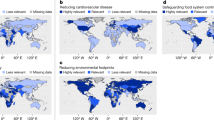Abstract
Wild foods, from forests and common lands, can contribute to food and nutrition security. Most previous studies have established correlations between wild food consumption and children’s dietary diversity in Africa, but other groups and geographic contexts remain understudied. Here a rigorous quasi-experimental method was combined with monthly interval data to assess the contribution of wild foods to women’s diets. We collected 24 h diet recall data monthly, from November 2016 to November 2017, from 570 households in East India. We found that wild foods contributed positively to diets, especially in June and July (when consumption of wild foods was highest). Women who consumed wild foods had higher average dietary diversity scores (13% and 9% higher in June and July, respectively) and were more likely to consume nutrient-dense, dark-green leafy vegetables than those who did not. Our results underscore the importance of policies that increase knowledge of wild foods and protect people’s rights to access forests and other common lands for improved nutrition.
This is a preview of subscription content, access via your institution
Access options
Access Nature and 54 other Nature Portfolio journals
Get Nature+, our best-value online-access subscription
$29.99 / 30 days
cancel any time
Subscribe to this journal
Receive 12 digital issues and online access to articles
$119.00 per year
only $9.92 per issue
Buy this article
- Purchase on Springer Link
- Instant access to full article PDF
Prices may be subject to local taxes which are calculated during checkout



Similar content being viewed by others
Data availability
The data that support the findings of this manuscript are available at https://openprairie.sdstate.edu/nrm_datasets/6/.
Code availability
The codes used for this analysis are available at https://openprairie.sdstate.edu/nrm_datasets/6/.
References
The State of Food Security and Nutrition in the World 2022. Repurposing Food and Agricultural Policies to Make Healthy Diets More Affordable (FAO, IFAD, UNICEF, WFP and WHO, 2022); https://doi.org/10.4060/cc0639en
Black, R. E. et al. Maternal and child undernutrition: global and regional exposures and health consequences. Lancet 371, 243–260 (2008).
Victora, C. G. et al. Revisiting maternal and child undernutrition in low-income and middle-income countries: variable progress towards an unfinished agenda. Lancet https://doi.org/10.1016/S0140-6736(21)00394-9 (2021).
Stevens, G. A. et al. Micronutrient deficiencies among preschool-aged children and women of reproductive age worldwide: a pooled analysis of individual-level data from population-representative surveys. Lancet Glob. Health 10, e1590–e1599 (2022).
Von Grebmer, K. et al. 2017 Global Hunger Index: The Inequalities of Hunger (Int. Food Policy Res. Inst., 2017); https://doi.org/10.2499/9780896292710
IPCC Climate Change and Land: An IPCC Special Report on Climate Change, Desertification, Land Degradation, Sustainable Land Management, Food Security, and Greenhouse Gas Fluxes in Terrestrial Ecosystems (Cambridge Univ. Press, 2019).
Miller, D. C., Mansourian, S. & Wildburger, C. Forests, Trees and The Eradication of Poverty: Potential and Limitations: A Global Assessment Report IUFRO World Series Vol. 39 (IUFRO, 2020).
Newton, P., Miller, D. C., Byenkya, M. A. A. & Agrawal, A. Who are forest-dependent people? A taxonomy to aid livelihood and land use decision-making in forested regions. Land Use Policy 57, 388–395 (2016).
Newton, P., Kinzer, A. T., Miller, D. C., Oldekop, J. A. & Agrawal, A. The number and spatial distribution of forest-proximate people globally. One Earth 3, 363–370 (2020).
India State of Forest Report (FSI, 2019).
Sustainable Forestry for Food Security and Nutrition. A Report by the High Level Panel of Experts on Food Security and Nutrition of the Committee on World Food Security HLPE Report 11 (FAO, 2017).
Rowland, D., Ickowitz, A., Powell, B., Nasi, R. & Sunderland, T. Forest foods and healthy diets: quantifying the contributions. Environ. Conserv. 44, 102–114 (2017).
Powell, B., Maundu, P., Kuhnlein, H. V. & Johns, T. Wild foods from farm and forest in the East Usambara Mountains, Tanzania. Ecol. Food Nutr. 52, 451–478 (2013).
Bharucha, Z. & Pretty, J. The roles and values of wild foods in agricultural systems. Philos. Trans. R. Soc. B 365, 2913–2926 (2010).
Avik Ray, R. R. The leafy greens of India—their diversity, pattern of consumption, and overriding implication on food and nutrition security. Agroecol. Sustain. Food Syst. 46, 432–451 (2022).
Wunder, S., Angelsen, A. & Belcher, B. Forests, livelihoods, and conservation: broadening the empirical base. World Dev. 64, S1–S11 (2014).
Vinceti, B. et al. The contribution of forests and trees to sustainable diets. Sustainability 5, 4797–4824 (2013).
Pandey, D. K., Momin, K. C., Dubey, S. K. & Adhiguru, P. Biodiversity in agricultural and food systems of jhum landscape in the West Garo Hills, North-eastern India. Food Security 14, 791–804 (2022).
Olesen, R. S., Hall, C. M. & Rasmussen, L. V. Forests support people’s food and nutrition security through multiple pathways in low- and middle-income countries. One Earth 5, 1342–1353 (2022).
Narayanan, S. Food security from free collection of foods: evidence from India. Food Policy 100, 101998 (2021).
Gergel, S. E. et al. Conceptual links between landscape diversity and diet diversity: a roadmap for transdisciplinary research. BioScience 70, 563–575 (2020).
Galway, L. P., Acharya, Y. & Jones, A. D. Deforestation and child diet diversity: a geospatial analysis of 15 Sub-Saharan African countries. Health Place 51, 78–88 (2018).
Ickowitz, A., Powell, B., Salim, M. A., & Sunderland, T. C. H. Dietary quality and tree cover in Africa. Glob. Environ. Change 24, 287–294 (2014).
Rasolofoson, R. A., Hanauer, M. M., Pappinen, A., Fisher, B. & Ricketts, T. H. Impacts of forests on children’s diet in rural areas across 27 developing countries. Sci. Adv. 4, eaat2853 (2018).
Rasmussen, L. V. et al. Forest pattern, not just amount, influences dietary quality in five African countries. Glob. Food Security 25, 100331 (2020).
Hall, C. M. et al. Deforestation reduces fruit and vegetable consumption in rural Tanzania. Proc. Natl Acad. Sci. USA 119, e2112063119 (2022).
Raghunathan, K., Headey, D. & Herforth, A. Affordability of Nutritious Diets in Rural India (Elsevier, 2021).
Bharucha, Z. & Pretty, J. The roles and values of wild foods in agricultural systems. Philos. Trans. R. Soc. B 365, 2913–2926 (2010).
Blaney, S., Beaudry, M. & Latham, M. Contribution of natural resources to nutritional status in a protected area of Gabon. Food Nutr. Bull. 30, 49–62 (2009).
Boedecker, J., Termote, C., Assogbadjo, A. E., Van Damme, P. & Lachat, C. Dietary contribution of wild edible plants to women’s diets in the buffer zone around the Lama forest, Benin—an underutilized potential. Food Security 6, 833–849 (2014).
Yadav, R. K., Kalia, P., Kumar, R. & Jain, V. Antioxidant and nutritional activity studies of green leafy vegetables. Int. J. Agric. Food Sci. Technol. 4, 707–712 (2013).
Ghosh-Jerath, S., Singh, A., Magsumbol, M. S., Kamboj, P. & Goldberg, G. Exploring the potential of indigenous foods to address hidden hunger: nutritive value of indigenous foods of Santhal Tribal Community of Jharkhand, India. J. Hunger Environ. Nutr. 11, 548–568 (2016).
Sunderland, T. C., & Vasquez, W. Forest conservation, rights, and diets: untangling the issues. Front. For. Glob. Change 3 (2020).
Oliveira Chaves, L. et al. Applicability of machine learning techniques in food intake assessment: a systematic review. Crit. Rev. Food Sci. Nutr. https://doi.org/10.1080/10408398.2021.1956425 (2021).
Patnaik, S. PESA, the Forest Rights Act, and tribal rights in India. In Proc. International Conference on Poverty Reduction and Forests, 3–7 (Rights and Resources Initiative, 2007).
Kumar, K., Singh, N. & Gira Rao, Y. Promise and performance of the Forest Rights Act. Econ. Polit. Wkly, 52, 40–3 (2017).
WorldBank. PovcalNet: an online analysis tool for global poverty monitoring. PovcalNet (2019).
Singh, K. & Kushwaha, C. Diversity of flowering and fruiting phenology of trees in a tropical deciduous forest in India. Ann. Bot. 97, 265–276 (2006).
Zavaleta, J. Women’s Role in Ensuring Seasonal Food Security in Rainfed India. PhD thesis, Univ. of Michigan (2019).
Thorat, S. & Newman, K. S. Caste and economic discrimination: causes, consequences and remedies. Econ. Polit. Wkly, 42, 4121–4124 (2007).
Bose, P., Bas, A. & van Dijk, H. ‘Forest governmentality’: a genealogy of subject-making of forest-dependent ‘scheduled tribes’ in India. Land Use Policy 29, 664–673 (2012).
Tripathi, P. Tribes and forest: a critical appraisal of the tribal forest right in India. Res. J. Soc. Sci. Manag. 6, 1–8 (2016).
Champion, H. G. & Seth, S. K. A Revised Survey of the Forest Types of India (Manager of Publications, 1968).
Agarwal, B. A Field of One’s Own (Cambridge Univ. Press, 1995).
Chopra, K. & Dasgupta, P. Nature of household dependence on common pool resources: an empirical study. Econ. Polit. Wkly 43, 58–66 (2008).
Jodha, N. S. Common property resources and rural poor in dry regions of India. Econ. Polit. Wkly 21, 1169–1181 (1986).
Berkes, F., Davidson-Hunt, I. & Davidson-Hunt, K. Diversity of common property resource use and diversity of social interests in the western Indian Himalaya. Mt. Res. Dev., 18, 19–33 (1998).
Nandi, R., Nedumaran, S., & Ravula, P. The interplay between food market access and farm household dietary diversity in low and middle income countries: a systematic review of literature. Glob. Food Security 28, 100484 (2021).
The State of Food and Agriculture 2016. Climate Change, Agriculture, and Food Security (FAO, 2016).
Verborgh, R. & De Wilde, M., Using OpenRefine (Packt Publishing Ltd, 2013).
Minimum Dietary Diversity for Women. An Updated Guide to Measurement – From Collection to Action (FAO, 2021); https://doi.org/10.4060/cb3434en
Martin-Prével, Y. et al. Moving Forward on Choosing a Standard Operational Indicator of Women’s Dietary Diversity (FAO, 2015).
Stuart, E.A., King, G., Imai, K. & Ho, D., MatchIt: nonparametric preprocessing for parametric causal inference. J. Stat. Softw. https://doi.org/10.18637/jss.v042.i08 (2017).
Diamond Alexis, S. J. S. Genetic matching for estimating causal effects: a general multivariate matching mehod for achieving balance in observational studies. Rev. Econ. Stat. 95, 932–945 (2013).
King, G. & Nielsen, R. Why propensity scores should not be used for matching. Polit. Anal. 27, 435–454 (2019).
Zeileis, A., Köll, S. & Graham, N. Various versatile variances: an object-oriented implementation of clustered covariances in R. J. Stat. Softw. 95, 1–36 (2020).
Google Earth Engine Data Catalog, Sentinel-2. Google https://developers.google.com/earth-engine/datasets/catalog/sentinel-2 (2019).
Google Earth Engine Data Catalog, Sentinel World Cover. Google https://developers.google.com/earth-engine/datasets/catalog/ESA_WorldCover_v100 (2020).
Acknowledgements
We thank F. Jalali and the Revitalizing Rainfed Agriculture Network for their logistical support collecting the data. We also acknowledge funding from the Borlaug Fellowship in Global Food Security Program; Marshall Weinberg Population, Development and Climate Change, Dow Environmental Sustainability Doctoral Fellowship; and from Rackham Graduate School at the University of Michigan. B.d.B. and L.V.R. were funded by the European Research Council (ERC) under the European Union’s Horizon 2020 Research and Innovation Programme (grant agreement no. 853222 FORESTDIET).
Author information
Authors and Affiliations
Contributions
J.Z.C. and A.C. facilitated data collection. J.Z.C., N.J.L., L.V.R., A.D.J. and A.C. developed the conceptual model for the paper. L.V.R. and N.J.L. did initial modelling and statistical analysis and matching analysis was completed by B.d.B. D.G. made maps. D.G., N.A. and A.C. provided cultural and historical context for the paper. All authors discussed the results and contributed to the final manuscript.
Corresponding author
Ethics declarations
Competing interests
The authors declare no competing interests.
Peer review
Peer review information
Nature Food thanks Terry Sunderland, Erin Sills and Michaela Lo for their contribution to the peer review of this work.
Additional information
Publisher’s note Springer Nature remains neutral with regard to jurisdictional claims in published maps and institutional affiliations.
Supplementary information
Supplementary Information
Supplementary information.
Rights and permissions
Springer Nature or its licensor (e.g. a society or other partner) holds exclusive rights to this article under a publishing agreement with the author(s) or other rightsholder(s); author self-archiving of the accepted manuscript version of this article is solely governed by the terms of such publishing agreement and applicable law.
About this article
Cite this article
Cheek, J.Z., Lambrecht, N.J., den Braber, B. et al. Wild foods contribute to women’s higher dietary diversity in India. Nat Food 4, 476–482 (2023). https://doi.org/10.1038/s43016-023-00766-1
Received:
Accepted:
Published:
Issue Date:
DOI: https://doi.org/10.1038/s43016-023-00766-1



